The former pipeline executive who spoke on condition of anonymity laughed when asked about first responders finding leaks. “This unodorized gas can soak into the ground around the pipeline. You can’t see it, smell it, taste it. And then boom!
“The fact of the matter is that this is simply gross negligence by the Railroad Commission, the state and federal government, and the city of Fort Worth,” he said. “There should be requirements that these lines be made with new USA steel and that they’re clearly marked in English and Spanish. But that’s not the case. So no, mapping 150 miles of lines isn’t going to do a lot to save a lot of people.”

Lobdill said that having the information on pipe locations available immediately to first responders is very important. The ability to check addresses near a fire, for instance, and learn that there is a high-pressure wet-gas pipeline running 15 feet from front porches could easily save lives.
But he’s not convinced that the data entered in the city’s map will be accurate. “Pipelines tend to wander a bit,” he said. “They might take a jog here and there. Moreover, the depth at which these are buried varies. Over time the surface can erode or be filled in, changing the initial depth at which they were installed.”
Lobdill pointed to the gathering line in Arlington that crosses Rush Creek south of Loop 820. “That line was in a heavily populated area, and yet it was exposed in the creek, with the arroyo below the pipe. Whenever it rained, things would get caught on that pipe. Now that is a disaster waiting to happen.”
The exposed pipe was highlighted in a Channel 8/WFAA-TV news story in 2010. Atmos Energy’s pipeline company spokesperson Jennifer Ryan told Fort Worth Weekly that her company has completed the Rush Creek line project, and the exposure [of the high-pressure 20-inch pipe] has “been completely remediated.”
Even if Fort Worth can make gas lines locatable by GPS, the city is depending on information supplied by the pipeline companies, and that won’t always be accurate, said Lobdill.
“It’s all well and good to tell a company to give exact information,” he said, “but they have contractors going out to lay the pipe, and if they have to move it just a bit, I’ll bet that information isn’t recorded. And that happens all the time. … It’s better than having nothing, but it’s not going to be perfect.”
Movement becomes more of a problem as lines age. “When you have a pipeline failure, an explosion, you call the pipeline company first to have the line shut down. But you don’t always know which company owns the line if it’s more than five years old. And if it’s been sold, you might have a situation where the new company didn’t get or properly record all of the exact information,” Lobdill said.
Deaver agreed with Lobdill that the city’s effort to accurately map the post-2009 gathering lines is a step in the right direction but far short of a real remedy. “Even if first responders know where the gas lines are, they still will not be permitted to turn off shut-down valves or even be taught how to find them. And if they can’t do that, if they’ve got to get the gas company to do that, well, that leaves the fire departments with their hands tied.”
In the San Bruno, Calif., explosion in 2010 that killed eight and leveled a neighborhood, it took the pipeline company 90 minutes to identify the line — a dry-gas transmission line — and shut it down.
“And that is just not excusable,” Deaver said. “It leaves the pipeline companies completely in the driver’s seat.”
********
There’s another problem that Deaver considers even more dangerous in the long run than not having accurate data on pipeline locations.
Traditional oil pipelines, if hit, will leak before they rupture, he said. Gas pipelines also leak, over time, as do the distribution lines running to homes. But if a gas gathering or transmission pipeline is damaged — by a backhoe, for instance — it will rupture immediately. “They’re a hazard just from shrapnel. When a big pipeline explodes, you can’t even find all the pieces of the pipe,” Deaver said.
“The pressure of the gas and the nature of the gas simply cause them to rupture on impact. If you really wanted to prevent gas line explosions, [the walls of] gas lines would have to be three times as thick as they are,” he said.
Deaver considers pipelines to be a relatively safe way to move gas, but only if they are regulated properly. Stronger, thicker steel construction is particularly important in an urban environment, he said. “Imagine a pipeline that’s hit and ruptures. Imagine a tear in that line that’s maybe 12 inches long. That would cause a strong small fire. But the way the lines are built now, that small rupture will automatically explode and maybe rupture for hundreds of feet.
“The solution is there. It’s just money. But the cost issue is so great that pipeline companies are not going to do it unless they’re pushed. And the way things are now, regulators don’t have scientists telling them what to do. They depend on the pipeline companies telling them what needs to be done.
“The oil and gas industry is one of the most powerful lobbies in the United States,” he said. “They have been able to fight regulations and get exceptions more than any other group. For them it’s still the Wild West, with the result in a place like Fort Worth being the possible death of hundreds of people in a pipeline explosion.”
He doesn’t see anything changing any time soon. In his experience, he said, people tend to respond to disasters rather than taking steps to prevent them.
********
Mapping doesn’t remove all the dangers of gas pipelines, but the city’s slow progress on getting pipelines mapped has upset activists who have been pushing for years for the city to take a stronger role — or any role, really — in protecting the health and safety of its citizens.
“It took them three years to come up with the money to create a system and another year to get it done, and now, four years after the city was supposed to start, they’re finally getting to it,” Hogan said.
It wasn’t foot-dragging by gas companies that caused the problem, he said. “The story the city used to give us was that bonus and royalty monies the city got were mostly earmarked — that they didn’t have a pot of money from which to pay someone to map those pipelines, despite all the millions the city got from those gas companies.
“But then, issues related to gas drilling never seem to be high on the city’s agenda,” he said.
Hogan finds it hard to believe that at this time there is no indication that the city plans to map the pre-2009 gas lines. “Not having those pipelines mapped is a danger to the city and our citizens,” he said.
“The whole thing is backasswards,” said Lobdill. “You would think that because of what is going through [gathering] lines and where they are located, they would have the most regulation. But they don’t. They are the least regulated pipelines.”
Trice said he doesn’t know if the city is going to ask for the older pipelines to be located and mapped once the current project is done.
“We’ll see,” he said. He does have faith that the partial pipeline map, with line sizes and pressures marked, will be a valuable tool. So is the existing requirement that companies post permanent signs with the company name and an emergency number wherever a pipeline crosses a street right-of-way. “The more tools, the better,” Trice said.
“In the end,” Ortiz said, “should a pipeline emergency arise, we think we’ve got everyone on the same page, and that’s the best we can do. The job is to minimize danger to everyone involved.”
“Roll the dice,” said Hogan. “Just pray it doesn’t come up snake eyes.”












Great article.
I can only imagine the potential disasters awaiting the poor working guys who have to do the dirty, dangerous job of construction digging when Fort Worth’s pipeline documentation is so miserably bad.
Meanwhile, the demagogues who run Fort Worth continue to function as ‘two dollar whores’ for any and all business ventures, especially energy industry business, that wave money under a Cowtown politician’s nose.
About the pipeline explosion in Cleburne:
TRRC Williams stated they receive 1. 8,000,000 dig request per year and only 1 percent results in a nick of the pipeline. That is 18,000!
http://www.wfaa.com/news/local/Oil-well-explodes-in-Hood-County-95801134.html
About the pipeline explosion in Cleburne:
TRRC Williams stated they receive 1. 8,000,000 dig request per year and only 1 percent results in a nick of the pipeline. That is 18,000!
www@wfaa@com/news/local/Oil-well-explodes-in-Hood-County-95801134.html
About the pipeline explosion in Cleburne:
TRRC Williams stated they receive 1. 8,000,000 dig request per year and only 1 percent results in a nick of the pipeline. That is 18,000!
www@wfaa@com/news/local/Oil-well-explodes-in-Hood-County-95801134@html
About the pipeline explosion in Cleburne:
TRRC Williams stated they receive 1. 8,000,000 dig request per year and only 1 percent results in a nick of the pipeline. That is 18,000!
www@wfaa@com/
news/local/
Oil-well-explodes-in-Hood-County-95801134@html
About the pipeline explosion in Cleburne:
TRRC Williams stated they receive 1. 8,000,000 dig request per year and only 1 percent results in a nick of the pipeline. That is 18,000!
Your mobile app is buggy,sorry about dup post